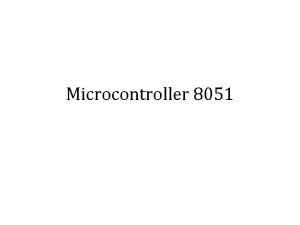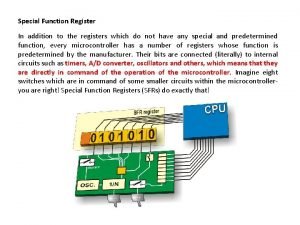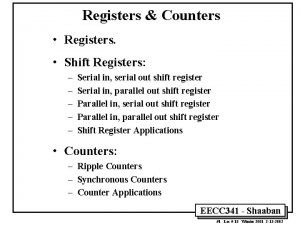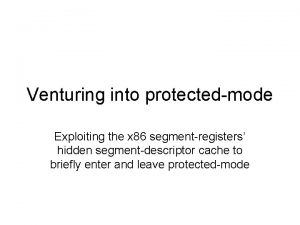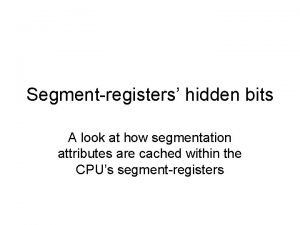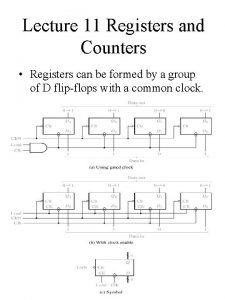Special segmentregisters How to utilize registers FS and

![Code/Data Descriptor-Format 63 32 Base[31. . 24] A D CR Limit GD L V Code/Data Descriptor-Format 63 32 Base[31. . 24] A D CR Limit GD L V](https://slidetodoc.com/presentation_image/4508a1a5f42d41b37d9d6981c1ef6521/image-2.jpg)







- Slides: 9

Special segment-registers How to utilize registers FS and GS for addressing memory-operands while in IA-32 e mode
![CodeData DescriptorFormat 63 32 Base31 24 A D CR Limit GD L V Code/Data Descriptor-Format 63 32 Base[31. . 24] A D CR Limit GD L V](https://slidetodoc.com/presentation_image/4508a1a5f42d41b37d9d6981c1ef6521/image-2.jpg)
Code/Data Descriptor-Format 63 32 Base[31. . 24] A D CR Limit GD L V P P SX / / A [19. . 16] L L DW Base[15. . 0] 31 Base[23. . 16] Limit[15. . 0] 0 Legend: G = Granularity: (0=byte-granularity, 1=page-granularity) D = Default operand address size: (0=16 -bits, 1=32 -bits) L = Long (0=compatibility mode code/data, 1=64 -bit code) AVL = Available (this bit can be used by programmers for any purpose) NOTE: These descriptors can only store 32 -bits as a segment’s base-address

IA 32_FS_BASE • This Model-Specific Register is now a part of the official Intel Architecture • It provides a “back door” to the hidden part of segment-register FS • It allows use of a 64 -bit base-address for segment-register addressed by FS when the CPU is executing in 64 -bit mode • Its MSR register-index is 0 x. C 0000100

Loading register FS • In “compatibility” mode the upper 32 -bits of the “hidden” 64 -bit segment base-address for FS will be disregarded by the CPU for computing memory-operand addresses • But in 64 -bit mode the full 64 -bit value of the “hidden” FS segment’s base-address will be used in forming effective addresses • How does FS segment-base get loaded?

It depends on cpu mode • In “compatibility” mode, we continue to put segment-sectors into register FS: mov $sel_fs, %ax, %fs • This loads the bottom 32 -bits into FS from the Global (or the Local) Descriptor Table • The upper 32 -bit are unmodified, and are disregarded, in “compatibility” mode

Use ‘wrmsr’ in 64 -bit mode • In 64 -bit mode, the ‘wrmsr’ instruction can be used to load the full 64 -bits of segment base-address into the “hidden” part of the FS segment-register: mov base_lo 32, %eax mov base_hi 32, %edx mov $0 x. C 0000100, %ecx wrmsr

GS is similar • The foregoing remarks about register FS also apply to register GS • There is a 64 -bit IA 32_GS_BASE register that is accessed with ‘rdmsr’ and ‘wrmsr’ • Its MSR register-index is 0 x. C 0000101

The ‘swapgs” instruction • There is a third Model Specific Register that gets used (in 64 -bit mode) with the IA 32_GS_BASE register, officially named the IA 32_KERNEL_GS_BASE register • Its MSR register-index is 0 x. C 0000102 • A special instuction can be used by ring 0 code to exchange the contents of these two Model-Specific Registers

In-class exercise • Use our ‘newapp 64. cpp’ development-tool to quickly create the boilerplate code for a boot-time program that takes the CPU into its IA-32 e mode (where you can try some experiments with registers FS and GS, as well as the privileged ‘swapgs’ instruction) • Can you “map” the topmost page-frame to video-memory, then use IA 32_FS_BASE to write a message to screen-memory?

